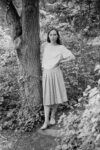The train passes through forests and fields dusted with snow, only half-melted from a few nights before. My classes have been cancelled for the day, so I’ve decided to take a short day trip to Kutná Hora, a small town with a population of just over 20,000, around an hour’s train journey from Prague, with a change at Kolín. There is very little to see in Kutná Hora, except for Sedlec Ossuary, otherwise known as “the Church of Bones.”
 If you didn’t know otherwise, you couldn’t be blamed for thinking this was just another Gothic church, not dissimilar from the many others that can be seen all across the Czech Republic. It is, in fact, one of six historic churches in Kutná Hora, and even among those, it’s relatively small in size, tucked away in a quiet suburb, away from the center of town. Inside, however, arranged in pyramids and hanging from the vaulted ceilings, are thousands and thousands of human bones. A conservative estimate is that the décor is made up of 40,000 skeletons, but it could be as many as 70,000. The arrangements were made in 1870 by František Rindt, but the story of the Bone Church goes back to 1278, when the abbot of Sedlec went to the Holy Land and came back with some soil from what was traditionally believed to be Golgotha, the site of Jesus’ crucifixion. He sprinkled it on the churchyard, and when word got out, the small church became one of the most popular burial sites in central Europe.
If you didn’t know otherwise, you couldn’t be blamed for thinking this was just another Gothic church, not dissimilar from the many others that can be seen all across the Czech Republic. It is, in fact, one of six historic churches in Kutná Hora, and even among those, it’s relatively small in size, tucked away in a quiet suburb, away from the center of town. Inside, however, arranged in pyramids and hanging from the vaulted ceilings, are thousands and thousands of human bones. A conservative estimate is that the décor is made up of 40,000 skeletons, but it could be as many as 70,000. The arrangements were made in 1870 by František Rindt, but the story of the Bone Church goes back to 1278, when the abbot of Sedlec went to the Holy Land and came back with some soil from what was traditionally believed to be Golgotha, the site of Jesus’ crucifixion. He sprinkled it on the churchyard, and when word got out, the small church became one of the most popular burial sites in central Europe.
The entire site is the product of an obsessive fixation on death and that which surrounds it, which has been an integral part of Catholicism since the Middle Ages. Salvation is perceived as a matter not only of life, but also of death; from Christ’s upon the cross, in which God passing out of the world reconciled the world to God, to the believer’s own death, the ”good death,” for which the Christian is to spend their entire life preparing (the ars morendi). This reverence is best seen in the strong material culture that has built up as a result of this preparation, a ritual and aesthetic appreciation and commemoration of death and the various marks it leaves upon the world, from the soil at Golgotha and other relics of Christ’s passion to the remains of believers, whether saintly or otherwise. This way of thinking can sometimes be difficult to understand for the contemporary mind. When St. Francis Xavier’s arm went on a tour of Canada, many reacted with bemusement or disgust, unable to grasp the significance of this severed limb for many among the faithful.
Yet Sedlec Ossuary is probably the most popular tourist site in the Czech Republic outside the capital. When I go, even on an overcast winter afternoon, there must be at least two dozen people crammed into the small crypt. Although I’m initially taken aback by suddenly being faced with so many human remains, the weight of their life now passed all around me, it’s surprisingly easy to be drawn into the light-heartedness of a family day out, even in spite of myself. Mostly disregarding the signs requesting silence, the tourists chat (mostly in Russian and English with American accents) and laugh, pointing out particularly interesting dents and cavities in the skulls. The dissonance between the severe impression of the Ossuary itself and the breezy and convivial manner in which many visitors were responding to it was both fascinating and troubling. Mightn’t one expect greater reverence while literally surrounded by bones?
This could be the result of a desensitizing of death in the contemporary mind. It is often commented that in the contemporary West, death is usually hidden. We keep our corpses medically sealed in bags and in mortuaries, and the event itself is often commemorated by a quiet evasion as a “celebration of life.” At the same time, in some ways, death is more visible than it has ever been. Media and popular culture are saturated with images of death, from popular horror films to the real-life horrors of wars, school shootings, and police brutality that regularly circulate through the news and social media. Disturbingly, the correspondence between horror films as a form of entertainment and documentation of real events pertains not only to content, but also to form. One can locate the videos of extrajudicial killings of black people that regularly proliferate through the internet in a history of entertainment media, going back to lynchings, that under Jim Crow were seen as a kind of public holiday, even featuring souvenir photos—a display of the power white people had and have over black life. Death is by no means as “hidden” as we might pretend, nor is it the abstract “universal” that is often spoken of in both secular and theological discourse. Our material cultures of death coalesce around political lines, in which those who have power are protected from their mortality, whereas the mortality of the powerless is made into a spectacle for mass consumption.
While it can be easy to treat Catholicism, with its institutional claim to timelessness and universality, as an eternally stable monolith, it must be remembered that it too shares in these political histories. The fascination with death perhaps first emerged from the persecuted community of the earliest Christians in the Roman Empire, but another key formative period was the fourteenth century, in which the infamous Black Death killed 30-60% of Europe’s total population, creating widespread social upheaval and instability. This sparked a widespread fascination with mortality, a key example being the poetic and theatrical tradition of the Danse Macabre, but one might also link it to the sudden rise in movements of popular piety, and what today we might call “mysticism,” such as Devotio Moderna. The social impact of the upheaval was mixed; while changing social conditions gave more power to the peasantry, leading to a number of peasant revolts across Western Europe, popular prejudices and a long history of Christian antisemitism meant that the crisis also frequently led to pogroms against Jewish communities, who were blamed for the disease. The immense force of cultural production through which contemporary Catholic representations of death have been formed emerge from a series of complex histories combining a gesture of repentant universality with violence against particular communities, a death both dealt out to scapegoated others and received as a moment of repentance, ecstasy, or even political revolt.
Returning to the present, some of these ambivalences can be traced through more secular engagements with death and its representation. Eren Orbey has written sensitively about the role of his fascination with horror films in relation to his father’s murder when he was three years old. Watching depictions of death, or even just its anticipation, helped Orbey to process the loss he was forced to face in a way that other more conventional comforts couldn’t. Ambivalently oscillating between morality play and “outlet for empathy,” the horror film becomes a space for working through that which can be difficult to engage with through other, more jovial cultural forms. Dr. Steven Marans of Yale’s Childhood Violent Trauma Centre tells Orbey:
You can turn away. You can turn down the volume. You can experience the level of arousal, the somatic sense of fear, and know in the back of your mind that it’s not forever. We are sometimes drawn compulsively to the very things that scare us—as a method of mastering them.
Leaving the Ossuary, I notice a small staircase, partially obscured by scaffolding, leading up the side of the building. Venturing up, I come to a small chapel, the church itself—it’s so easy to forget that this is an ordinary church, and that the tourist attraction is just the equivalent of the basement. There are a few rows of red-cushioned plastic chairs, and I sit down and turn my eyes to the altar. The chapel is relatively unadorned: some biblical scenes appear on the walls, but it’s otherwise plain. At the altar I see a simple baroque crucifix; below, statues of Mary and John the Evangelist, looking up at the dying God.
Jonathan Murden writes a monthly column of cultural theology. Murden is an Orthodox Christian and undergrad currently based in Prague.
This post may contain affiliate links.







